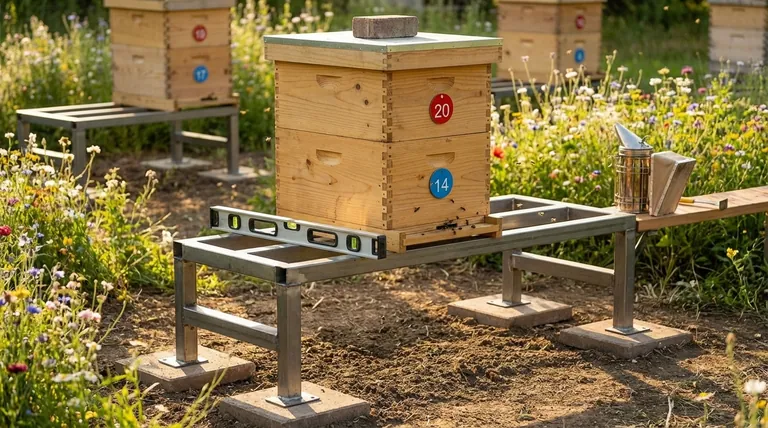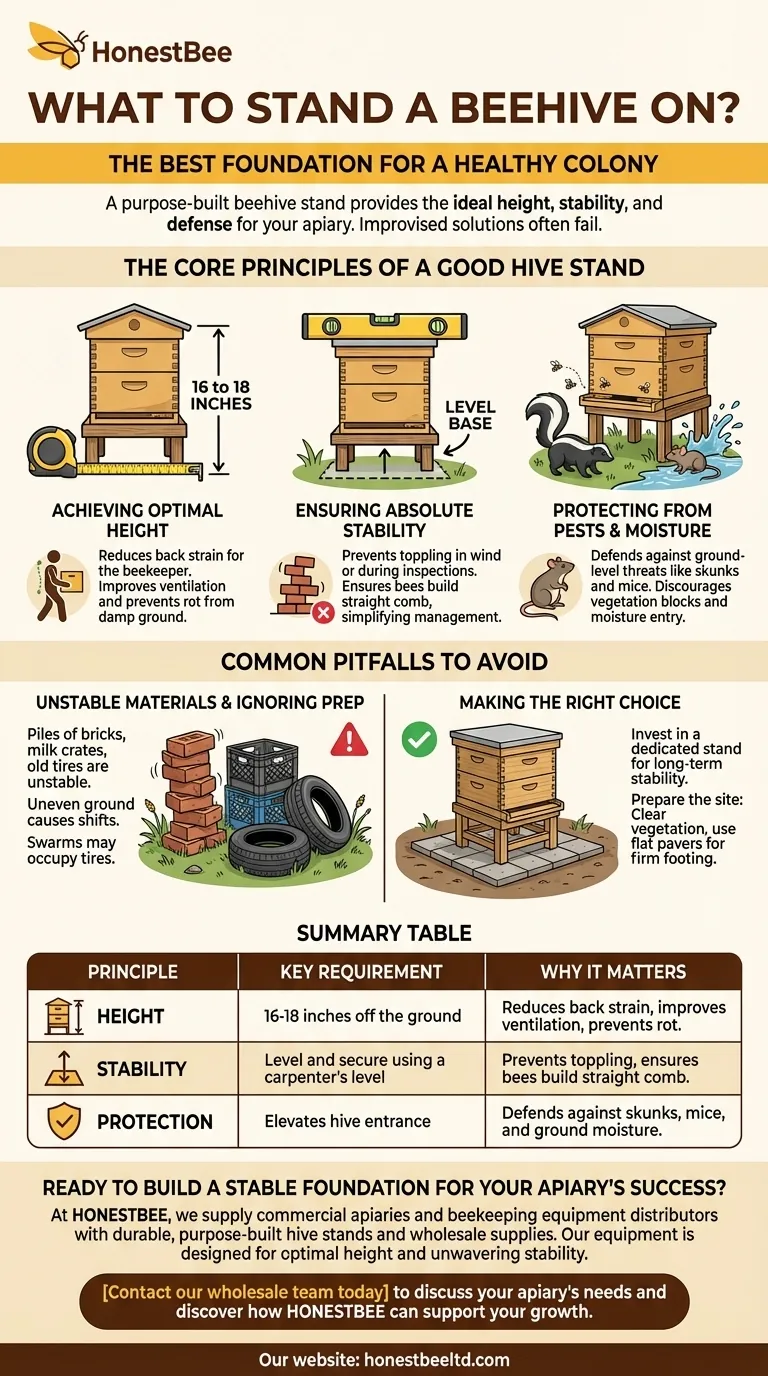The best foundation for a beehive is a purpose-built beehive stand. These stands are specifically designed to provide the ideal height and stability required for both the health of the bee colony and the comfort of the beekeeper. While improvised solutions like bricks or milk crates are common, they often introduce instability and pest issues that a proper stand avoids.
The primary goal of a beehive stand is not just to elevate the hive, but to create a stable, level, and defensible platform that simplifies management and protects the colony from ground-level threats.

The Core Principles of a Good Hive Stand
Choosing the right stand is about understanding the fundamental requirements for a healthy and manageable beehive. Three factors are paramount: height, stability, and protection.
Achieving the Optimal Height
The ideal height for a beehive stand places the hive entrance 16 to 18 inches off the ground.
This specific elevation serves two key purposes. First, it raises the hive to a comfortable working height for most adults, minimizing the back strain that comes from lifting heavy boxes (supers) filled with honey. Second, it lifts the hive well clear of damp ground, improving ventilation and protecting the wooden components from rot.
Ensuring Absolute Stability
A beehive must be perfectly stable and level. Use a carpenter's level during setup to ensure the stand is level both side-to-side and front-to-back.
An unstable or tilted hive can be dangerous, with the risk of it toppling over during inspections or in high winds. Furthermore, bees use gravity to build their comb perfectly straight. A level hive ensures they build straight, orderly comb within the frames, making inspections far easier and less disruptive to the colony.
Protecting from Pests and Moisture
Elevation is the hive's first line of defense. A stand keeps the entrance out of reach of pests like skunks and reduces the likelihood of mice entering for warmth in the winter.
It also prevents moisture from splashing up from the ground into the hive entrance and discourages vegetation from blocking the bees' flight path.
Common Pitfalls to Avoid
Many beekeepers are tempted by DIY solutions, but these often come with hidden trade-offs that can compromise the hive's health and your own safety.
Using Unstable Materials
Piles of bricks, stones, or plastic milk crates are notoriously unstable. A slight nudge or settling of the ground can cause the hive to shift or even fall, which is a catastrophic event for the colony.
Ignoring Site Preparation
Placing a perfect stand on soft, uneven ground defeats the purpose. Always prepare the site by clearing vegetation and ensuring the ground is firm and compacted. Placing flat paving stones or bricks under the stand's feet provides a much more secure footing.
Choosing Situational Solutions
Old tires are sometimes used in remote locations, like on the heather, but they come with a significant risk. As the reference notes, a swarm may decide to occupy the tire itself, creating a nuisance you will have to manage.
Making the Right Choice for Your Apiary
Your choice of stand should align directly with your beekeeping goals.
- If your primary focus is long-term stability and ease of management: Invest in a well-made, dedicated beehive stand that positions the hive at the recommended 16-18 inch height.
- If you need a temporary or emergency solution: Use solid concrete blocks as a base, but take extra care to ensure they are wide, stable, and perfectly level before placing the hive on top.
Properly supporting your hive from day one is a critical investment in its future success.
Summary Table:
| Principle | Key Requirement | Why It Matters |
|---|---|---|
| Height | 16-18 inches off the ground | Reduces back strain, improves ventilation, prevents rot. |
| Stability | Level and secure using a carpenter's level | Prevents toppling, ensures bees build straight comb. |
| Protection | Elevates hive entrance | Defends against skunks, mice, and ground moisture. |
Ready to build a stable foundation for your apiary's success?
At HONESTBEE, we supply commercial apiaries and beekeeping equipment distributors with the durable, purpose-built hive stands and wholesale supplies needed for long-term colony health and efficient management. Our equipment is designed to provide the optimal height and unwavering stability your operation requires.
Contact our wholesale team today to discuss your apiary's needs and discover how HONESTBEE can support your growth.
Visual Guide

Related Products
- Professional Engraved Round Hive Number Tags for Beekeeping
- Plastic Bee Hive Stand for Beekeeping
- Metal Hive Feet Bee Hive Stand for Ant Protection
- Metal Bee Hive Stand Bee Box Stand for Beekeeping
- Yellow Plastic Bucket Pail Perch for Beekeeping
People Also Ask
- What is the purpose of a hive stand, and why is it beneficial? Elevate Your Hive for Colony Health and Beekeeper Comfort
- How can hive stands be made more secure in windy areas? Anchor Your Apiary Against the Elements
- What are the characteristics of Posca pens for marking queens? A Safe, Durable Solution for Hive Management
- Why is it recommended to buy at least two bee hives? Boost Your Success with a Second Colony
- Why should beekeepers consider using hive stands? Protect Your Hives and Your Back



















